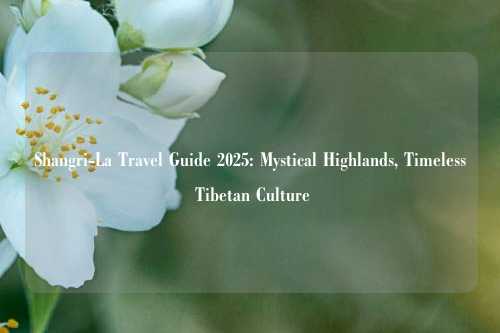Shangri-La Travel Guide 2025: Mystical Highlands, Timeless Tibetan Culture
Nestled in the heart of the Yunnan Province, Shangri-La—once a mythical paradise imagined in James Hilton’s 1933 novel Lost Horizon—has evolved into a real-world destination that captivates travelers with its sacred landscapes and vibrant Tibetan culture. Founded in the 13th century as a trading post along the ancient Tea Horse Road, this highland city (elevation 3,300 meters) has preserved its mystical allure while embracing modern tourism.

City Overview
Shangri-La, also known as Zhongdian, sits at the crossroads of three major rivers—the Jinsha, Lancang, and Nujiang—blessing it with alpine meadows, turquoise lakes, and snow-capped peaks. The region’s history as a cultural melting pot is evident in its architecture, cuisine, and traditions. Tibetans form the majority of the population, maintaining centuries-old customs in villages like Xiaozhongdian.
Climate & Best Seasons
Shangri-La’s climate is mild but unpredictable. Summers (June–August) are ideal for hiking, with temperatures averaging 15–20°C. Winters (December–February) bring crisp air and occasional snow, perfect for cultural exploration. Spring (March–May) and autumn (September–November) offer vibrant flora and stable weather.
| Season | Temperature | Activities |
|---|---|---|
| Spring | 5–18°C | Wildflower hikes, Tibetan New Year festivals |
| Summer | 12–22°C | Trekking, lakeside picnics, horse riding |
| Autumn | 8–20°C | Photography tours, monastery visits |
| Winter | -5–10°C | Cultural workshops, snowshoeing |
Why Visit Shangri-La?
Living Tibetan Culture: Explore monasteries like Songzanlin (Yunnan’s largest, housing over 700 monks) and witness daily prayers at the Great Stupa.
Pristine Nature: Pudacuo National Park’s alpine lakes and forests are a UNESCO World Heritage Site, home to rare species like the black-necked crane.
Adventure Hub: Trek the Tiger Leaping Gorge or summit Baima Snow Mountain for panoramic views of the Himalayas.
Top 5 Attractions
Songzanlin Monastery
History: Founded in 1679, this monastery blends Tibetan and Han architecture.
Best Time: Morning prayers (6–8 AM) or during Losar (Tibetan New Year, late January/early February).
Pudacuo National Park
Highlights: Bitahai Lake’s crystal waters, Shudu Lake’s meadow trails.
Best Time: Autumn for golden larches; spring for blooming rhododendrons.
Dukezong Ancient Town
Explore: Cobblestone streets lined with tea shops and Tibetan handicrafts. Visit the former residence of the 5th Dalai Lama.
Tip: Arrive early to avoid crowds and capture the town’s serene morning light.
Napahai Wetland
Experience: Horseback rides through marshlands, seasonal birdwatching (black-necked cranes in winter).
Best Time: Year-round, but most vibrant in summer.
Baima Snow Mountain
Adventure: Hike to the 4,292-meter summit or explore Niding Forest’s hidden waterfalls.
Permits: Required for high-altitude treks; book through licensed operators.
5-Day Itinerary
Day 1: Arrive via flight to Diqing Airport. Acclimatize in Shangri-La with a stroll through Dukezong’s old town.
Day 2: Visit Songzanlin Monastery; drive to Jinsha River’s Daguaiwan for sunset.
Day 3: Full-day Pudacuo National Park tour, including Bitahai and Shudu lakes.
Day 4: Trek Baima Snow Mountain’s lower slopes or explore Napahai Wetland by bike.
Day 5: Cultural immersion: Attend a Tibetan calligraphy class, then depart.
Food & Restaurants
| Dish | Description | Recommended Restaurant |
|---|---|---|
| Tsampa (糌粑) | Roasted barley flour mixed with yak butter tea | Zhaoba Noodle House (Old Town) |
| Yak Butter Tea | Salty tea with yak butter, traditional energy drink | Songtsam Hotel Restaurant |
| Yak Steak | Grilled with herbs, tender and flavorful | Shangri-La Tibetan Cuisine |
Accommodation Guide
| Hotel | Location | Price (USD/CNY) | Rating |
|---|---|---|---|
| Songtsam Linka | Songzanlin Monastery area | 1,400 | 4.8/5 |
| LUX* Tea Horse Road | Downtown | 2,450 | 4.9/5 |
| Arro Khampa Nansuoda | Near Napahai | 1,050 | 4.5/5 |
Travel Tips
Altitude Sickness: Avoid strenuous activity for 24–48 hours; carry diamox or drink coca tea.
Cultural Respect: Always clockwise around stupas; remove hats in monasteries.
Cash: Many rural areas lack ATMs; carry RMB for markets and small shops.
Visa & Entry
Citizens of 54 countries enjoy a 10-day visa-free stay via Beijing, Shanghai, or Guangzhou airports. New policies (2025) include 21 additional entry ports, simplifying access for independent travelers.
FAQ
Is Shangri-La safe for solo travelers?
Yes, with low crime rates. Use licensed guides for remote treks.
Can I visit monasteries during festivals?
Most welcome visitors but check schedules, as some areas may restrict access during private ceremonies.
What’s the best way to reach Shangri-La?
Fly into Diqing Airport (DIG) or take a scenic 4-hour drive from Lijiang.
My Expertise
Since 2018, I’ve helped over 3,000 travelers craft unforgettable China journeys. This guide is updated annually with firsthand insights—save time, stress, and money by following my recommendations. For personalized advice, reach out via email (xuansc2144@gmail.com) or WeChat (xuansc2144).
Explore Shangri-La Your Way
Whether you’re chasing spiritual enlightenment or alpine adventures, Shangri-La’s blend of mystery and accessibility promises a journey like no other. Book your trip today and let the legends come alive!












